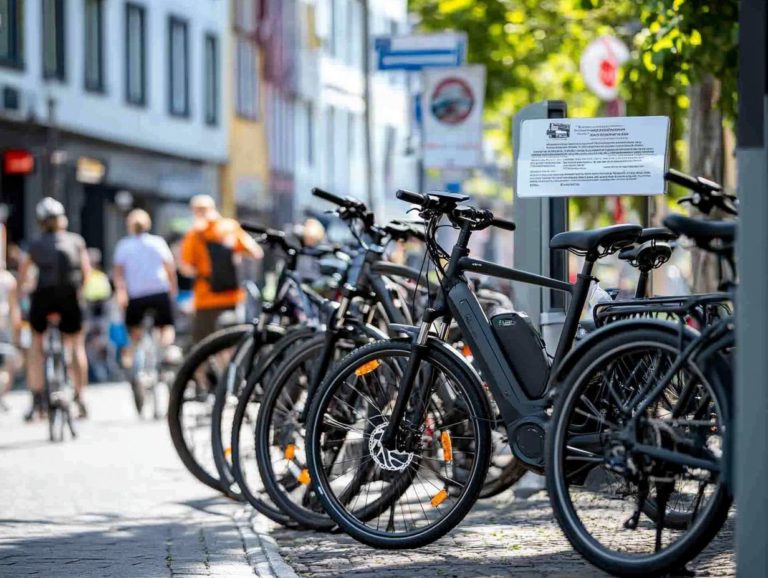The Future of Electric Bicycle Legislation
Electric bicycles, or e-bikes, are revolutionizing your perception of transportation. As their popularity surges, grasping the current landscape of e-bike legislation becomes essential.
This article delves into the existing laws and regulations that govern electric bicycles. It presents a balanced view of the arguments for and against their legalization, including insights from organizations like PeopleForBikes.
You ll explore proposed amendments that may influence future legislation. Additionally, we will conduct a thorough evaluation of the broader societal impact, including environmental and transportation considerations, particularly concerning the e-bike market.
Join us on this exciting journey through e-bike laws as you navigate the evolving topic of electric bicycle legislation and contemplate its future in the context of e-bike trends and innovations.
Contents
- Key Takeaways:
- Current State of Electric Bicycle Legislation
- Arguments for and Against Electric Bicycle Legislation
- Potential Changes in Electric Bicycle Legislation
- Impact of Electric Bicycle Legislation on Society
- Predictions and Recommendations
- Frequently Asked Questions
- 1. What is electric bicycle legislation and why is it important for the future?
- 2. Will electric bicycles be classified as motorized vehicles in the future?
- 3. How will electric bicycle legislation affect the sales and production of electric bicycles?
- 4. What are the current regulations for electric bicycles in different countries?
- 5. Will there be stricter laws for electric bicycle usage in the future?
- 6. How can I stay updated on changes to electric bicycle legislation?
Key Takeaways:

- Electric bicycle laws are changing rapidly, and understanding them is essential, with varying regulations across different regions, especially concerning e-bike safety and bike infrastructure.
- Arguments for and against electric bicycle legislation highlight both potential benefits and drawbacks, such as increased accessibility, e-bike safety, and the need for robust bike infrastructure.
- The future of electric bicycle legislation may involve proposed amendments and updates to current laws, particularly addressing e-bike regulations that align with the growth of the electric bicycle industry.
What is an Electric Bicycle?
Electric bicycles, or e-bikes, are a new combination of traditional cycling and electric power. They cater to a diverse range of riders, whether you re exploring the city at a leisurely pace with low-speed e-bikes or tackling rugged trails with electric mountain bikes.
With an integrated electric motor that supports you as you pedal, e-bikes enhance your commuting experience. They also promote a more active lifestyle while benefiting the environment.
The electric bicycle industry showcases an impressive variety of designs. From cargo e-bikes perfect for families to low-speed models ideal for urban commuting, these adaptable machines are equipped with advanced batteries to meet your travel needs and preferences.
As organizations like PeopleForBikes and Dr. Ash Lovell champion cycling as an essential facet of urban mobility, e-bikes are increasingly appealing to environmentally conscious consumers seeking sustainable alternatives to traditional vehicles. Their potential to minimize carbon footprints while providing eco-friendly transportation options is driving their rapid rise in popularity in cities around the globe. However, it’s important to be aware of regulations, such as understanding electric bicycle laws in California, especially for those in regions like Germany and the Netherlands.
Current State of Electric Bicycle Legislation
The current landscape of electric bicycle legislation presents a complex and nuanced scenario. It varies markedly from region to region, influenced by factors like the Consumer Product Safety Commission and safety standards for e-bikes.
It’s shaped by safety standards established by organizations such as the U.S. Consumer Product Safety Commission. These guidelines are critical for the electric bicycle industry, alongside state-specific electric bicycle legal frameworks aimed at ensuring e-bikes meet specific safety and performance criteria.
As e-bikes gain traction, particularly in urban settings, the demand for strong bike infrastructure and comprehensive regulations becomes increasingly urgent. This approach is crucial for addressing emerging hazards and promoting safe and responsible usage of electric bicycle brands and cargo e-bikes.
Overview of Laws and Regulations
The landscape of laws and regulations surrounding electric bicycles is shaped by numerous factors, including evolving safety standards and emerging hazards. There is also a pressing need for technical resources to address mechanical hazards and ensure compliance with consumer product safety guidelines.
Navigating these complexities is crucial for ensuring safety. Different jurisdictions may impose varying regulations concerning types of e-bikes, particularly for cargo bikes and electric mountain bikes. To better understand the rules, check out navigating electric bicycle licensing requirements. Organizations such as PeopleForBikes and the U.S. Consumer Product Safety Commission play a vital role in promoting resources that help clarify these regulations.
These organizations provide essential information on safety protocols, educate stakeholders about potential risk factors, and promote adherence to established e-bike standards.
By empowering riders and manufacturers with knowledge about potential hazards, these entities aim to cultivate a safer environment for everyone involved in the expanding e-bike sector, especially as innovations like connected bikes emerge.
Arguments for and Against Electric Bicycle Legislation

The discussion surrounding electric bicycle legislation presents a spectrum of arguments, both for and against its enactment. Advocates from the electric bicycle industry emphasize the need for improved bike infrastructure, especially in urban areas, and safety regulations that address specific e-bike types.
Critics voice concerns about potential misuse and the environmental repercussions stemming from unclear e-bike regulations. They stress the importance of having well-defined rules.
Pros and Cons of Legalization
The legalization of electric bicycles brings a complex mix of advantages and disadvantages regarding e-bike safety regulation. Advocates highlight the environmental benefits and improved accessibility for urban transportation, promoting active methods of travel. Conversely, critics raise valid concerns about e-bike safety and the potential for increased accidents if consumer product safety standards aren t upheld, particularly with heavy-duty models.
Proponents argue that integrating e-bikes into the regulatory framework can greatly enhance urban mobility, allowing users to maneuver through congested city streets effortlessly. Innovations from brands like Super73, Trek, and Specialized facilitate this shift, reducing the carbon footprint of transportation and encouraging healthier lifestyles as more individuals opt for cycling over driving. For a deeper understanding of the rules surrounding e-bikes, refer to the electric bicycle regulations: a global overview.
However, it is absolutely critical to establish stringent consumer product safety regulations now, as the e-bike market continues to grow. With careful oversight, the rise of electric bicycles can evolve into a safe and sustainable urban transport solution. Staying informed about the future of electric bicycle innovation can help minimize associated risks, including mechanical hazards.
Potential Changes in Electric Bicycle Legislation
As the electric bicycle market flourishes, discussions about potential legislative changes are gaining momentum, focusing on e-bike regulations that foster innovation. These conversations aim to address the shifting dynamics of e-bike technology, rider behavior, and the implications of C-V2X (Cellular Vehicle-to-Everything) technology and Velco.
There’s a growing demand for proposed amendments and updates to existing regulations that align with these new realities.
Proposed Amendments and Updates
Proposed amendments and updates to e-bike regulations are essential for accommodating the diverse range of electric bicycles, including cargo electric bikes and electric mountain bikes. It s important that safety standards reflect the unique challenges and requirements associated with these vehicles, particularly regarding their design and functionality.
Clearer classifications based on e-bike size, weight, and functionality can significantly enhance safety protocols. This is especially true for heavy-duty models designed for transporting goods, like those used by FedEx and UPS. By establishing specific criteria tailored to cargo electric bikes, regulators can improve infrastructure, such as dedicated lanes and parking areas, that support both urban and rural e-bike usage. This not only enhances rider safety but also encourages more people to embrace e-bikes as a viable alternative to traditional transport and prepares for the future of electric bicycle maintenance technologies.
Electric mountain bikes present a different set of circumstances that require specific attention in regulation. Updated regulations can address important features, like improved braking systems and tire requirements, ensuring optimal performance on rugged terrains for electric mountain bikes. These proposed changes aim to strike a balance that fosters innovation while prioritizing the safety and convenience of all e-bike riders. For insights into what lies ahead, check out the future of electric bicycle types in 2024, ensuring that both regular and cargo electric bikes are included in safety discussions.
Impact of Electric Bicycle Legislation on Society

The influence of electric bicycle legislation on society is significant, reshaping urban transportation systems and encouraging active modes of travel, especially in major cities across France. This shift helps alleviate traffic congestion and delivers substantial environmental benefits, contributing to the overall quality of urban life.
By positioning e-bikes as a viable alternative, we contribute to the broader pursuit of sustainable mobility solutions, especially as the demand for electric bicycles grows.
Effects on Transportation and Environment
Electric bicycles are transforming urban transportation patterns and the environment, offering a cleaner, more efficient alternative to traditional vehicles through innovations in the electric bicycle industry. This amazing shift cuts emissions dramatically and encourages active transportation among citizens, promoting a healthier lifestyle.
In regions like Germany and the Netherlands, integrating e-bikes into daily commutes has completely changed how individuals navigate urban landscapes, cultivating a culture rooted in sustainability and supported by advanced bike infrastructure. Cities such as Amsterdam have seen a remarkable increase in cyclist numbers, resulting in reduced traffic congestion, improved air quality, and a stronger commitment to active transportation.
These e-bikes also bolster local economies by promoting short-distance trips that keep communities connected, enhancing the appeal of cargo bikes for local deliveries. This transition not only enhances your quality of life but also highlights the significance of electric bicycles as a crucial element in the broader strategy for urban mobility and environmental stewardship. To ensure safe riding, it’s important to be aware of the top electric bicycle laws. Together, we can promote e-bike safety and standards.
Join the movement for greener cities by embracing e-bikes today!
Predictions and Recommendations
Predictions for the future of electric bicycles indicate a positive growth in the industry, driven by emerging trends and endorsements from organizations like PeopleForBikes, which aim to create a supportive environment for e-bike adoption and foster connections among stakeholders.
As technology continues to evolve, improvements such as longer battery life, enhanced connectivity features, and lighter materials are set to capture your attention as a potential consumer. You can expect market growth as cities worldwide embrace sustainable transportation initiatives. Increased acceptance of e-bikes will likely come from their growing presence in urban planning and targeted promotional campaigns, along with a better understanding of electric bicycle safety regulations.
Stakeholders are encouraged to prioritize the enhancement of e-bike infrastructure, which includes dedicated lanes and charging stations, along with implementing safety measures that ensure you feel secure while riding.
Frequently Asked Questions
1. What is electric bicycle legislation and why is it important for the future?

Electric bicycle legislation refers to laws and regulations governing the use of electric bicycles on public roads and paths. It is vital for ensuring the safety of riders and others on the road as electric bicycles gain popularity.
2. Will electric bicycles be classified as motorized vehicles in the future?
It’s unlikely that electric bicycles will be classified as motorized vehicles in the future. Many countries have already established separate classifications, recognizing their lower speeds and potential for human-powered pedaling.
3. How will electric bicycle legislation affect the sales and production of electric bicycles?
Electric bicycle legislation can significantly shape the market! Strict regulations may limit the availability of certain models, while more lenient laws might encourage more companies to produce and sell electric bicycles.
4. What are the current regulations for electric bicycles in different countries?
Regulations for electric bicycles vary widely across countries. In some places, they’re treated like traditional bicycles and do not require special licenses. In others, they may face speed or power limits, or even require registration and insurance like motorized vehicles.
5. Will there be stricter laws for electric bicycle usage in the future?
There may be stricter laws for electric bicycle usage in the future as their popularity rises. However, these laws will likely focus on safety measures rather than limiting the use of electric bicycles altogether.
6. How can I stay updated on changes to electric bicycle legislation?
To stay updated on changes to electric bicycle legislation, follow local news and government websites for any updates. Joining advocacy groups or forums dedicated to electric bicycles can also help you stay informed and voice your opinions on potential changes.
Stay tuned for more updates on electric bicycles!






